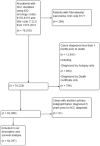Emerging trends in hepatocellular carcinoma incidence and mortality
- PMID: 25142309
- PMCID: PMC4823645
- DOI: 10.1002/hep.27388
Emerging trends in hepatocellular carcinoma incidence and mortality
Abstract
The rise in incidence of hepatocellular carcinoma (HCC) in the United States has been well documented. The purpose of this analysis was to examine temporal trends in HCC incidence, mortality, and survival within the U.S. population. The Surveillance, Epidemiology, and End Results data were used to examine incidence and incidence-based (IB) mortality in HCC from 1973 to 2011. Secular trends in age-adjusted incidence and IB mortality by sex and cancer stage were characterized using the Joinpoint Regression program. In 1973, HCC incidence was 1.51 cases per 100,000, whereas in 2011, HCC incidence was 6.20 cases per 100,000. Although HCC incidence continues to increase, a slowing of the rate of increase occurs around 2006. In a sensitivity analysis, there was no significant increase in incidence and IB mortality from 2009 to 2011. There was a significant increase in overall median survival from the 1970s to 2000s (2 vs. 8 months; P < 0.001). On multivariable Cox's regression analysis, age, sex, race, tumor grade, stage at diagnosis, lymph/vascular invasion, number of primary tumors, tumor size, and liver transplant were independently associated with mortality.
Conclusion: Our results indicate a deceleration in the incidence of HCC around 2006. Since 2009 and for the first time in four decades, there is no increase in IB mortality and incidence rates for HCC in the U.S. population. The nonsignificant increase in incidence and IB mortality in recent years suggest that the peak of the HCC epidemic may be near. A significant survival improvement in HCC was also noted from 1973 to 2010, which seems to be driven by earlier detection of HCC at a curative stage and greater utilization of curative modalities (especially transplant).
© 2014 by the American Association for the Study of Liver Diseases.
Figures






References
MeSH terms
Grants and funding
LinkOut - more resources
Full Text Sources
Other Literature Sources
Medical
